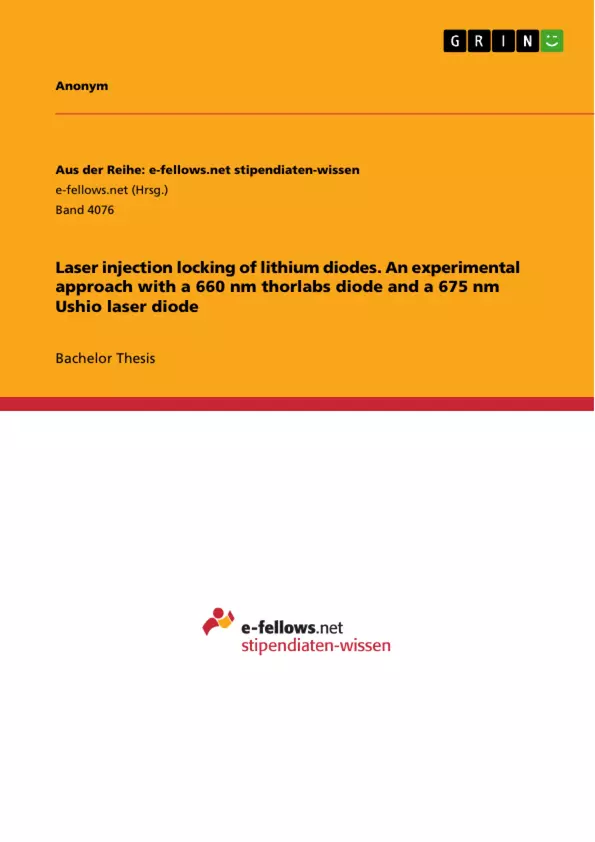The goal of this work is to find a stable injection lock setup with over 100 mW of output power. There are two diodes characterized for this aim while injection locking them. One is available at Thorlabs with a center wavelength of 660 nm and up to 120 mW of output power in the free-running state. The other diode manufactured by Ushio is not yet readily available on the market but has a center wavelength of 675 nm with up to 0,25 W of output power and can be directly operated at 671 nm by lowering the temperature. There are concerns that this temperature would be below the dew point, especially in summer.
This causes condensation on the diode from the water vapor in the air, explaining why this diode is tested only via the second approach. In Section 2 a short introduction into semiconductor laser physics is explaining the working principle of laser diodes. Additionally, the injection locking theory and the Gaussian beam model are discussed. The experimental setup and instrument control are described in Section 3. This is followed by the characterization of the Thorlabs diode with a center wavelength of 660 nm in Section 4 and the Ushio diode with a center wavelength of 675 nm at appropriate temperatures in Section 5. An outlook on further improving the setup by actively stabilizing the injection lock is given in Section 6. In cold atom experiments for laser cooling and trapping of atoms, laser powers of more than 100 mW are often required.
Furthermore, magneto-optical traps, while loading, are in need of sufficient power to reduce the number of atoms lost on the way. The output power of an external cavity diode laser does not produce enough output power for such applications. Alternatively, tapered amplifiers are a way to produce sufficient output power. These are currently not available for the targeted laser cooling wavelength for lithium of 671nm. However, injection locking of free-running, high power diodes is an alternative to tapered amplifiers for delivering enough output power. This is a technique to produce higher output power at a stable frequency. To achieve this, a weak signal of typically a few mW of an external cavity diode "seed" laser is injected into a free-running "slave" diode, which is capable of higher output power.
Inhaltsverzeichnis (Table of Contents)
- Introduction
- Theory of laser injection locking
- Semiconductor laser diodes
- p-n junction
- Fabry-Perot laser diode and interferometer
- External cavity diode laser
- Driven oscillator model for injection locking
- Mode-matching with the Gaussian beam model
- Properties of a Gaussian beam
- Gaussian beam propagation using ABCD-matrices
- Semiconductor laser diodes
- Experimental setup
- Setup with optical parts
- Instrument control
- Characterization of a 660 nm Thorlabs diode
- Free-running laser diode
- Wavelength tuning
- Lasing threshold
- Beam shaping
- Demonstration of injection locking
- Current dependency
- Lasing threshold in injection locked state
- Free-running laser diode
- Characterization of a 675 nm Ushio laser diode
- Free running diode
- Wavelength tuning
- Lasing threshold
- Beam shape and coupling efficiency
- Demonstration of injection locking
- Current dependency
- Current-temperature stability maps.
- Lasing threshold in injection locked state and variation of seed power
- Minimizing seed power
- Free running diode
- Active stabilization of injection locking
- Conclusion
- Acknowledgements
Zielsetzung und Themenschwerpunkte (Objectives and Key Themes)
The main objective of this work is to develop a stable injection locking setup that can produce over 100 mW of output power. To achieve this goal, two laser diodes with different characteristics are characterized and tested under injection locking conditions.
- Understanding the theory and practical application of laser injection locking.
- Analyzing the characteristics of semiconductor laser diodes, including their p-n junction, Fabry-Perot cavity, and mode-matching properties.
- Evaluating the performance of two different laser diodes for injection locking purposes.
- Exploring techniques for stabilizing the injection locking process.
- Developing a stable and high-power injection locking setup for applications in cold atom experiments.
Zusammenfassung der Kapitel (Chapter Summaries)
- Introduction: Provides an overview of the need for high-power lasers in cold atom experiments and introduces the concept of injection locking as a solution for achieving stable and powerful laser output.
- Theory of laser injection locking: Explains the underlying principles of injection locking, including the properties of semiconductor laser diodes, the driven oscillator model, and the importance of mode-matching.
- Experimental setup: Describes the experimental setup used for characterizing and testing the laser diodes, including the optical components and instrument control systems.
- Characterization of a 660 nm Thorlabs diode: Presents the results of characterizing the free-running properties of a 660 nm Thorlabs diode and then demonstrates its behavior under injection locking conditions.
- Characterization of a 675 nm Ushio laser diode: Provides a detailed characterization of a 675 nm Ushio laser diode, including its free-running characteristics and its performance under injection locking.
- Active stabilization of injection locking: Discusses potential methods for actively stabilizing the injection locking process to achieve greater stability and control.
Schlüsselwörter (Keywords)
The key topics and concepts explored in this work include laser injection locking, semiconductor laser diodes, p-n junctions, Fabry-Perot cavities, mode-matching, Gaussian beam propagation, and active stabilization techniques. These concepts are central to the development of stable and powerful laser systems for cold atom experiments.
- Quote paper
- Anonym (Author), 2021, Laser injection locking of lithium diodes. An experimental approach with a 660 nm thorlabs diode and a 675 nm Ushio laser diode, Munich, GRIN Verlag, https://www.grin.com/document/1145748



